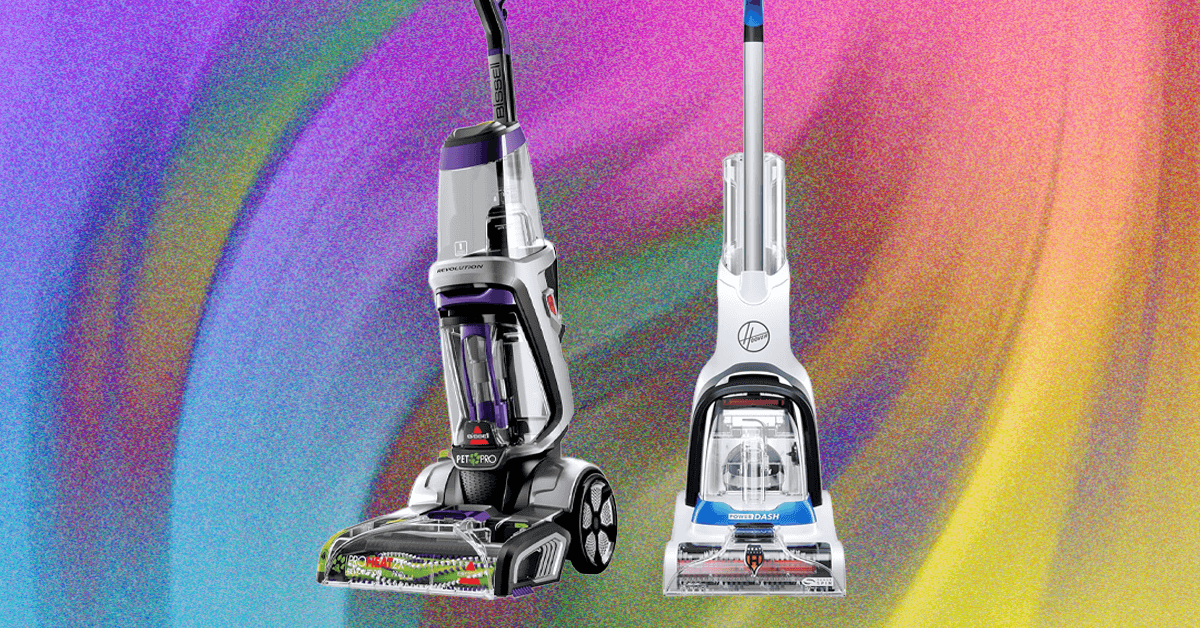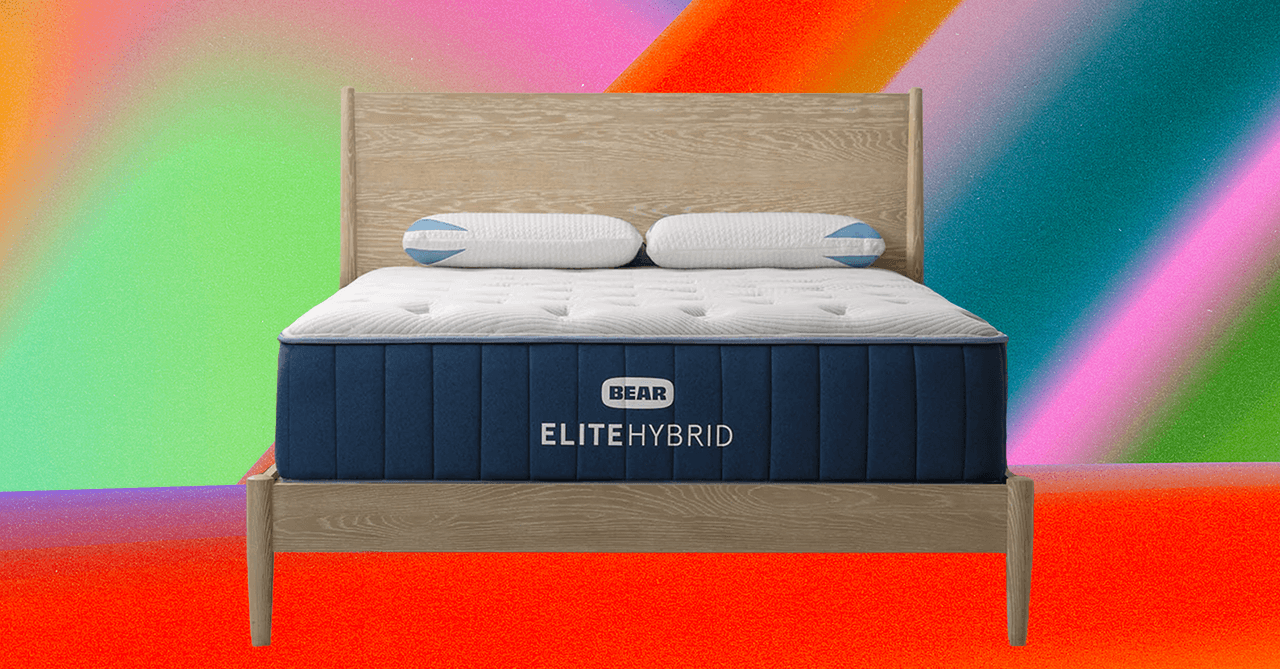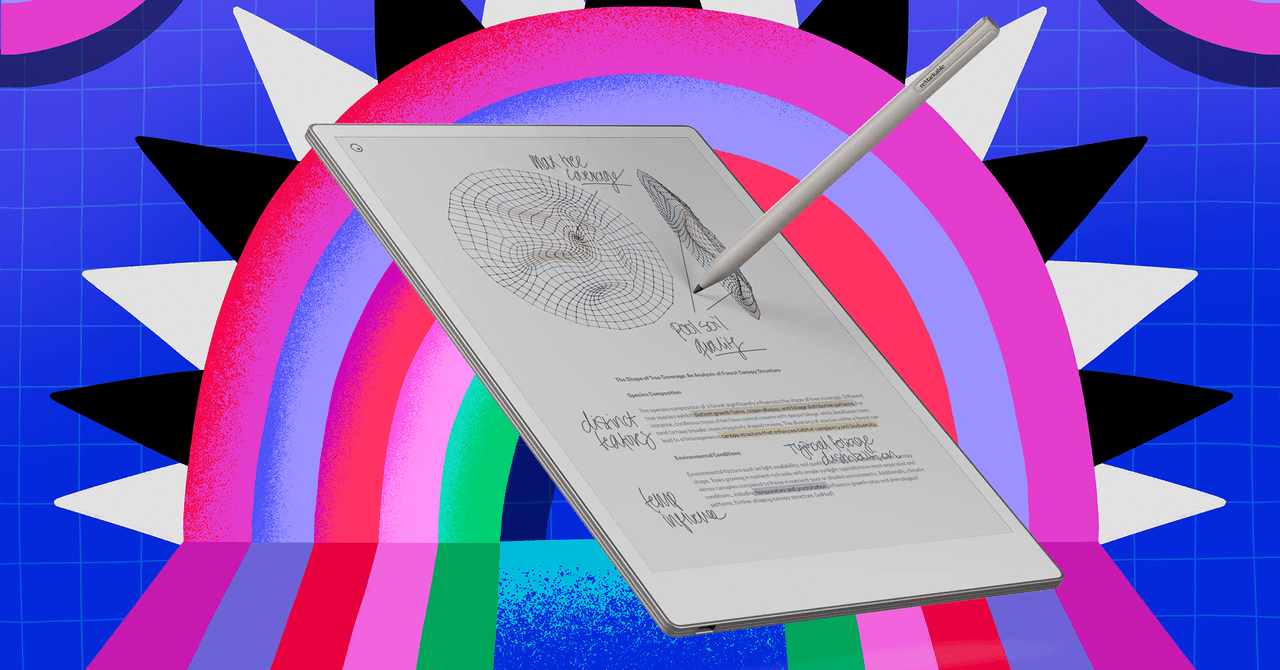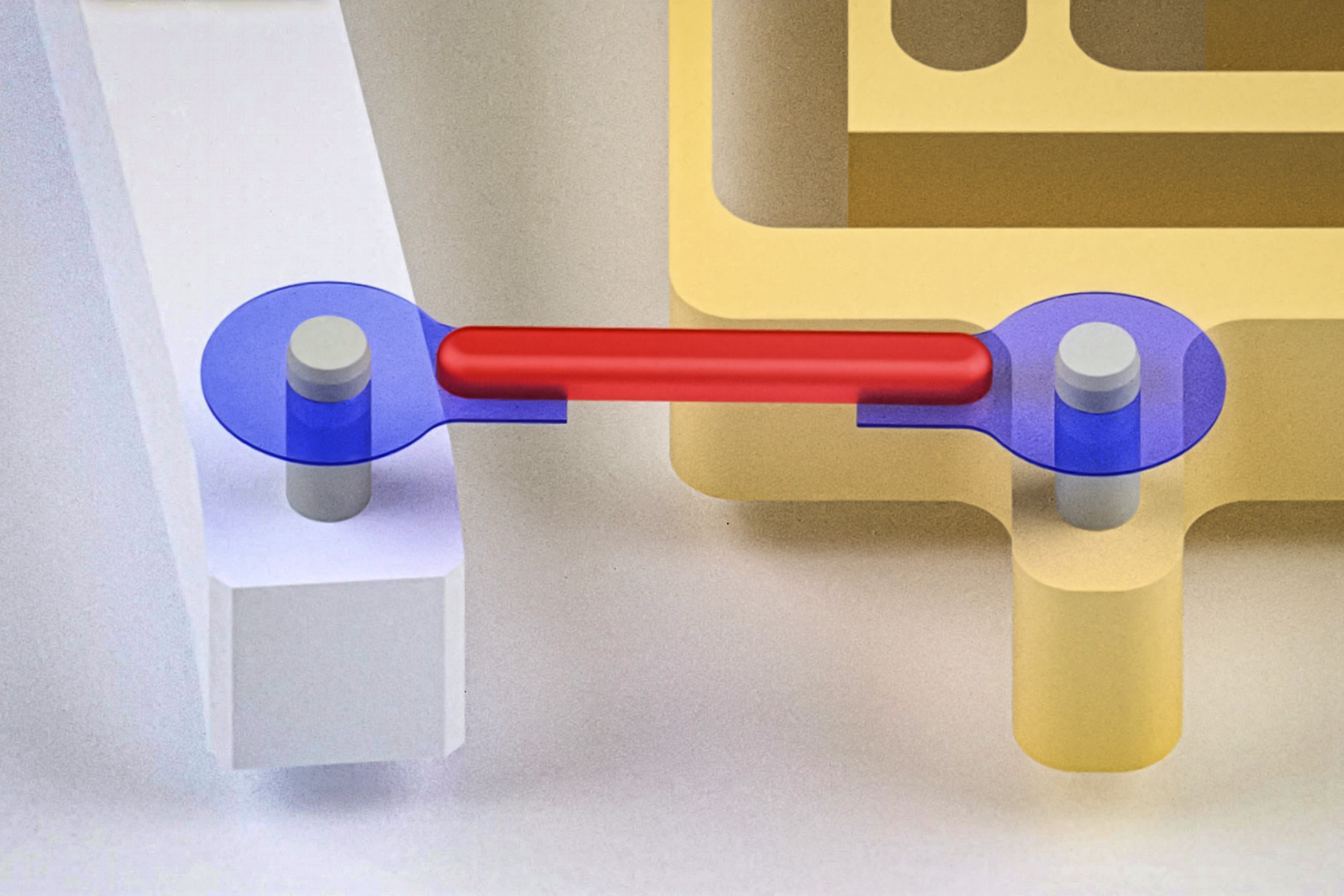Tech
The Best Carpet Cleaners We’ve Found, Tested in Busy Households

Compare Our Picks
Others Tested
Photograph: Simon Hill
Hoover HF4 Hydro for £199: For UK folks in flats or small houses with a mix of carpet and hard floor, this cordless, space-saving vacuum and mop from Hoover could be a smart pick. You get a standard cordless stick vac with around half an hour of battery life, but you can switch the head to mop. It’s excellent for cleaning hard floors, with a shape that gets right into corners and two rotating pads to lift stains. But the water tank, contained within the head, is tiny, the vacuum is only moderately powerful at lifting, and battery life drops to just 15 minutes in turbo mode.
Hoover SmartWash Automatic Carpet Cleaner for $250: It’s bulky, but it has automatic cleaning and drying cycles—pushing it forward releases the solution and pulling it back starts the drying process. After you’ve gone over the whole area, you can turn just the drying mode on for an extra pass if the carpet needs it. The handle comes out with the click of a button, and you can use its separate tank with a cleaning solution to spot-treat before vacuuming. A hose and separate antimicrobial pet tool can clean stairs or any other hard-to-reach areas that need extra elbow grease. Some customer reviews say it worked well for a few months but then shorted out. We’ll keep trying it to see if we run into that issue. —Medea Giordano
Bissell Little Green Portable Carpet Cleaner for $79: If you’ve landed on the cleaning side of TikTok, you’ve probably seen people cleaning their carpets and furniture with this Little Green machine. This opens up the world of upholstery cleaning too, not just carpets. It worked well and it’s easier to store and tote around your house than our top pick. But use the included hose-cleaning tool frequently. These hoses can get nasty. —Brenda Stolyar
Cleaners We Like for Hard Floors
Photograph: Simon Hill
Dreame H14 Pro for $380: The Dreame H14 Pro is quite large, but I found it easy to maneuver, and it can lie flat to get under furniture. A handy LED headlight helps you see what you are cleaning clearly. A full charge proved enough to do all my hard floors twice over, and the result was super shiny. What I love about this vac is that it effectively cleans up dry or wet spills, so whether you are cleaning cat litter or a spilled bowl of cereal, it performs. It’s best for cleaning recent spills but can shift stubborn stains with repeated passes on Ultra mode. When you finish, you can return it to the charging cradle and trigger the self-cleaning mode to sterilize the soft roller and dry it (though it gets loud and takes a long time). No one wants to install an app or create an account just to use a vacuum, but it enables you to choose modes and schedule the self-cleaning, which could be handy if you want it to wait until you go out. —Simon Hill
Shark S5003D Genius Steam Mop for $100: This steam mop is great for cleaning hardwood, tiles, or laminate flooring (not carpets). Simply fill the water tank, plug it in, and attach one of the mop pads. It has three heat levels, and you press down to release a jet of steam for stubborn stains. There’s no need for any detergent, it’s light and maneuverable, and it doesn’t require much space. The clever pad design enables you to flip it over when one side is soiled, and the mechanism makes it easy to attach, with a button to detach the dirty pad, which is machine washable. (You get two pads in the box.) I regularly use this mop to clean laminate, composite, and tile floors, but you must be careful using steam, especially on wood or vinyl flooring. Test it on the lowest heat setting before going over the whole floor. There are no special attachments or extras here, and it’s only suitable for use on hard floors. You also need to empty any remaining water if you don’t plan on using it for a while, or the tank can go nasty. —Simon Hill
Karcher SC 3 for $164: If your budget can stretch, this option is better if you want attachments and the option to steam-clean harder-to-reach surfaces and your hard floors. It’s good for complete kitchen or bathroom cleaning without the need for any detergent or other products. It’s effective for cleaning glass and mirrors too. It only comes with one microfiber cover, and it’s not recommended for use on fabrics or carpets. —Simon Hill
Not Recommended
Eufy E28 HydroJet Robot Vacuum with Carpet Cleaner for $1,400: I generally love Eufy’s attractive, smart, multipurpose robot vacuums, and since I have two dogs and two kids, I was expecting to love a robot vacuum that could also mop hardwood floors and has a detachable carpet cleaner. Unfortunately, the water injection system is wonky. It has to be perfectly positioned to get water from the portable carpet cleaner tank (I often had to tap it into place), and every time I mopped, it leaked constantly all over my kitchen floor. At least the carpet cleaner was effective. —Adrienne So
Things to Consider When Shopping for a Carpet Cleaner
There is a lot to think about when shopping for or using a carpet cleaner, such as how much space you’ll need for storage and whether you should rent or buy. Here are some tips to keep in mind.
Carpet cleaners are heavy and bulky, especially when filled with water. They can be harder to maneuver than regular upright vacuums. They will also need quite a bit of storage space.
Tackle stain-causing spills immediately. Most households only need to wash carpets once every six months to a year, but spot cleaners are ideal for treating immediate spills, plus they’re easier to store and use.
You likely won’t use a carpet cleaner often, so it’s OK to consider hiring professionals to do your whole home, especially if you have limited storage space. (It also can depend on how dirty and stained your carpets are.) Look at options for renting a machine from local businesses or retail stores like Home Depot. You’ll be able to get the benefits of a commercial-grade cleaner without paying a fortune.
Clean your carpet before you use a carpet cleaner. This may seem counterintuitive, but you don’t want dirt and hair to form wet clumps that block the cleaner. And if you haven’t washed your carpets in a while (or ever), be prepared for an embarrassing amount of hairy clogs to fill the dirty water tank.
The carpet shampoo or detergent you use is important. Manufacturers often insist you use their brand, and while other types may work fine, you might void your warranty (although I have no idea how they’d know). Most carpet cleaners come with some detergent.
Try, try, and try again. It can be disappointing to fire up a carpet cleaner and find that it’s incapable of removing that old red wine stain or ground-in toothpaste. Don’t lose heart. Multiple cleaning sessions can sometimes chip away at established stains, and at least reduce, if not remove, them.
Drying your carpets can take a long time. Most carpet cleaners have different settings, and they will suck up some of the water, but they all leave carpets a bit damp. The deeper cleans tend to leave carpets wet, so think about how you might speed drying time. Use fans, fire up the heating, or do your carpet cleaning in the spring and summer months when you can leave windows open.
Protect your hearing. Of all the ways you can damage your hearing, a carpet cleaner is perhaps the least fun, so protect your ears. Some of these get very loud, so wear earplugs while you work.
Power up with unlimited access to WIRED. Get best-in-class reporting and exclusive subscriber content that’s too important to ignore. Subscribe Today.
Tech
Wake Up—the Best Cyber Monday Mattress and Bedding Sales Are Here

If you’ve been dreaming all year of saving serious cash on a new mattress, you have a few more hours before the alarm goes off. From the best mattresses for back pain to our favorite cooling options, these are the top deals on mattresses the WIRED Reviews team has tested in their own homes. We also track prices all year to see where the best sales are really happening. And Cyber Monday brings some of the best sleep deals you’ll see all year.
If it’s on this list, it’s genuinely a good deal on a product someone from our team has tested and approved of. While the prices listed below are for queen sizes, the deals should apply to all mattress sizes. Your dreams of a new king mattress are still going strong.
Updated 2 pm ET December 1: We’ve added new sales from Sleep Number and Thuma, and ensured up-to-date links and prices.
WIRED Featured Deals
Bear
The WIRED Reviews team has crowned the Bear Elite Hybrid as the best mattress for back pain we’ve tested to date. It comes in three firmness options, including Soft, Medium, and Firm. WIRED testers have found Firm helpful for spinal alignment, and you can also add a Celliant cover for a fee, designed to help with muscle recovery. In addition to the sale, Bear is also throwing in a free accessories bundle (two pillows, a sheet set, and a mattress protector). Use WIRED40 for 40 percent off, which is an additional 5 percent off the offer you’ll see on the site.
Helix
We test many, many mattresses—so it’s saying something that the Helix Midnight Luxe has been our favorite overall mattress for seven years running. This specific model is designed for side sleepers, but the brand’s slogan is “designed for every body,” and there are plenty of options for every sleeping position. Helix’s Cyber Week sale is underway, but you can get additional savings by using our exclusive coupon code WIRED27 for 27 percent off.
Saatva
Saatva mattresses strive to be the intersection of luxury, natural materials, and support for many sleepers. One model in particular that we’ve tested, the Saatva Rx, offers serious pressure relief for even the most persistent aches and pains. It incorporates micro coils and pressure-relief foam, so the price is usually on the higher side. However, Saatva’s holiday sales promo should take some strain off your wallet, as you can save $400 off purchases of $1,000 or more. Use our link below.
Sleep Number
If you’re trying to decide between a sleep tracker or a new mattress, I’ve got news for you—Sleep Number can do both. The p6 is a smart bed that lets you adjust your preferred firmness; pressure relief levels; and, paired with an adjustable base, the angle of the head and foot of the bed. It also tracks your sleep, noting any changes in your heart rate, breathing, and deep sleep. Sleep Number is offering free shipping plus discounts for bed and base bundles. Free shipping’s a big deal because it’s usually a separate fee from Sleep Number for a team to come set up the bed for you. Now, it’s just part of your purchase.
Casper
Amazon’s current price on this Casper hybrid is slightly lower than we saw for Prime Day, at just over $1,000 for a queen from Amazon. Casper was one of the original American mattresses-in-a-box makers, though the company has been bought and sold a few times. We like this mattress for pressure relief but it has heightened support thanks to the coils. There’s also a sale on a Casper pillow we like below.
Birch
If you’re looking to get memory foams and other man-made materials out of your bedroom in favor of an all-organic mattress, the Birch Luxe Natural has been a consistent winner for us. It has an organic cotton Euro top that gives your pressure points a cushioned surface to slightly sink into. Layers of natural wool are incorporated underneath for breathable temperature control. Latex is pressure-relieving, like memory foam, but without any chemicals involved. It’s also organic, with Global Organic Latex Standard (GOLS) certification. Pocketed coils help support you where you need it most. Birch is also throwing in two free pillows with every mattress purchase. To make it even better, you can use code WIRED27 for even more savings.
Airweave
There is a significant savings on a mattress we really liked for its firmness and portability, while balking at the price in our review. The Airweave’s filling is made from a unique ultrafine woven polyethylene, which looks like uncooked glass noodles or a tangle of fishing line. It functions like super micro coils and offers a somewhat stiff but very. supportive sleeping surface. Best of all, it can be disassembled for easy moving, and the cover is washable.
Silk & Snow
Canadian brand Silk & Snow uses high-quality materials and thoughtful construction in its mattresses, with prices that are hard to argue with. In the S&S Organic hybrid’s case, there are several organic certifications too. With GOLS-certified organic cotton, organic wool, and GOLS-certified latex atop pocketed coils, it eliminates any guesswork about materials and focuses solely on support. For holiday shoppers, Silk & Snow is offering up to $300 off on mattresses, no code needed.
Avocado
Avocado takes the notion of “all-natural” mattresses very seriously, with an extensive list of certifications to back its claims. The Avocado Green hybrid mattress comes in Firm (base model), Medium (pillow top), and Plush (box top, which is an even thicker version of a softer pillow top). Medium and Plush cost a bit extra, but we previously tested the Firm model and loved it. Its organic latex and coil construction provided lumbar support, temperature regulation, and pressure relief to the point where it got a near-perfect score. For Avocado’s holiday mattress sale, you can take 20 percent off your purchase, no code needed.
Wolf
Wolf mattresses are not ones you should overlook. Each time our team has tested a Wolf mattress, we were impressed with its quality and performance. The Wolf 13-Inch Memory Foam Hybrid Premium Firm Mattress is quite a name, but this hybrid mattress excels with temperature control thanks to a cooling cover, foams, and coils. It’s just firm enough that you can move around without feeling stuck, and it also maintains spinal alignment. Wolf’s Cyber Week mattress sale is now live, with 15 percent off on your purchase.
Tiami
Tiami’s Luxury Hybrid has a firmer feel with cushioning memory foam layers and unique, foam-capped coils that help relieve pressure around your joints. It’s a specialty mattress through and through, which makes Tiami’s current mattress sale even more enticing. It’s the lowest price we’ve seen all year, thanks to its Cyber Monday promo at 40 percent off, no code needed.
Essentia
You’re searching high and low for an organic mattress, but not just any organic mattress will do—it has to be vegan as well. (Many organic mattresses aren’t vegan due to the inclusion of wool.) For those who aim to live (and sleep!) by vegan protocols, Essentia’s Tatami mattress is right up your alley. It’s got organic cotton, organic latex, and organic foam all meant for pressure relief, temperature control, and strong lumbar support. Essentia is offering 25 percent off mattresses plus two free pillows as part of its holiday mattress sale. (Discount reflected in cart.)
Naturepedic
Naturepedic checks a lot of boxes with its EOS Classic mattress. It’s got customizable firmness on each side of the mattress. It’s one of the best mattresses we’ve tested to date. It’s also made with organic materials, making it one of the best organic mattresses we’ve come across. Naturepedic is offering 20 percent off sitewide and throwing in a free accessories bundle (organic mattress protector and pillows) on orders of $699 or more.
Leesa
Leesa’s Sapira Chill Hybrid ranks as one of the best mattresses by our account (more specifically, the best hybrid mattress), thanks to its cooling and lumbar support. It features a quilted pillow top with a cooling cover, along with pressure-relieving foams and pocketed coils. There are three firmness levels to choose from, but if you have back pain, you may want to opt for something firmer to support spine alignment. Plus, the Sapira Chill’s pillow top will soften things out a bit. While the price for this mattress isn’t the lowest we’ve seen this year, Leesa’s holiday sale is pretty good. You can take 30 percent off select mattresses, including the Sapira Chill.
Plank
For those who feel like a mattress is never quite firm enough, the Plank Firm is one of the team’s favorite beds that delivers a truly firm feel. It’s actually dual-sided, with one side “firm” and the other “extra firm,” so you can get the utmost, unyielding support. It’s been a hit with some of our testers who have back pain and look to firm beds to maintain spine alignment. To keep your wallet balanced, too, Plank is offering 30 percent off with code BFRIDAY30.
Cyber Monday Bedding Deals
No new mattress setup would be complete without sheets, pillows, bed frames, and sleep accessories. Cyber Monday is the time to get the best of the best, and these are deals we’re pretty hyped about.
Thuma Signature Bed Frame
We’re big Thuma fans around here, from the Thuma Hybrid mattress to its Classic Bed frame (review coming soon!). We wish these two items were on sale for Black Friday, but Cyber Monday is a new day with new opportunities, like a sale on Thuma’s Signature Bed frame. Just like the Classic Bed, the Signature Bed frame is a cinch to set up and comes in either soft Italian felt or performance linen. Thuma is offering up to 22 percent off the Signature Bed as part of its Cyber Monday sale.
Casper Sleep Hybrid Snow Pillow
Another Casper sale you’ll find on Amazon, reviewer Nena Farrell found this pillow had a lower loft paired with a firmer feel. These are both aspects that stomach sleepers need from their pillows to prevent disturbing their neck’s cervical alignment and causing trouble with their lower backs.
My Green Mattress
You’re looking for a quick hack to revitalize your mattress’s support—before your guests arrive for the holidays. Mattress toppers can help buy you some time while increasing pressure relief, support, and overall comfort. This organic latex mattress topper from My Green Mattress has two inches of firmer-feeling, GOLS-certified Dunlop latex. For the holiday, you can get 15 percent off sleep accessories, including this organic latex topper.
Helix
Here’s another hypothetical for you, based on personal experience: You know someone living in a dorm, and their mattress just straight-up sucks. Sleep’s crucial for these scholars, and Helix’s GlacioTex Memory Foam Topper is designed to provide pressure relief and temperature regulation to help elevate the lowliest of dorm-room beds (aka, a glorified piece of foam wrapped in a tarp). Use code WIRED27 for 27 percent off this topper.
Cozy Earth
We’re covering all sorts of Cozy Earth deals right now. But these bamboo sheets are so lovely, we’re giving them a shoutout twice. If you’re still struggling with gift ideas, these sheets are a cooling, luxurious option the recipient will use often (at least, I’d sure use them). Plus, the limited edition seasonal patterns are too whimsical to pass up. These sheets are currently 45 percent off and are selling out quickly.
Brooklinen
If you crave the experience of being wrapped in something similar to a fluffy cloud, chances are you’d really like a down comforter. WIRED reviewer Louryn Strampe likened Brooklinen’s all-season down comforter to something you’d see in a hotel, with its starchy cover and fluffy fill. Brooklinen is continuing its 25 percent off sitewide sale from Black Friday through Cyber Week.
Coop
The first time I technically tested this crescent pillow was in a friend’s guest room, and I’ve been a fan ever since. This adjustable pillow’s bottom has an arch, allowing your shoulders to press into the pillow and providing more cushion around your neck. You can also add fill (which comes in a separate bag) to make it firmer, or take some out to increase softness. You can take 25 percent off as part of its current sitewide sale.
Power up with unlimited access to WIRED. Get best-in-class reporting and exclusive subscriber content that’s too important to ignore. Subscribe Today.
Tech
I’ve Tried Every Digital Notebook. Here Are the Best Ones on Sale

I love a digital notebook. I write about them all year long here at WIRED, and it’s not often my favorites go on sale. (Or for any to go on sale, besides Amazon’s own sale events.) But this year, multiple digital notebooks I love are on sale for the biggest sale event of the year.
If you’ve thought about getting one of these for yourself, there’s truly no better moment. From reMarkable’s on-sale bundles to Kobo’s deals, you can shop five of the best digital notebooks we’ve ever tried right now at a lower price than you might find until next year. They’re a handy device just about everyone can enjoy, whether you want to digitally annotate your books or write out your grocery list without using a piece of paper.
Looking for more great sales to shop? Don’t miss our guides to the Best Amazon Device and Kindle Deals, Best Laptop Deals, the Absolute Best Cyber Monday Deals, and our liveblog.
Update Dec. 1: We updated prices, links, and deals, and added the Rocketbook Fusion Plus notebook.
The Best Digital Notebook Deals
Some of the best digital notebooks we’ve tried come from reMarkable, and one of reMarkable’s models always seems to reign supreme over our digital notebooks guide. While the Paper Pro Move is the newest model, the reMarkable Paper Pro that launched in September 2024 is my current all-around favorite. It’s not only powerful with tons of tools and an easy interface, but packs a color screen for colorful notes. It also has a gentle front light so that you can use it in darker environments. You can get the bundles on sale right now, so combine one of reMarkable’s markers and folio covers with a Paper Pro to get $50 off.
The best discount from reMarkable is actually for its older device and our previous top pick, the reMarkable 2. It doesn’t have a color screen or the front light, but you’ll get the reMarkable’s great software and options for accessories like the Keyboard Folio to use it like a laptop. The reMarkable 2 bundles are also on sale, so add on your favorite folio of choice on reMarkable’s website to get $70 off.
The Kobo Libra Colour is my favorite all-around e-reader with its color screen and page turner buttons, but you can add on a stylus to have it double as a digital notebook. It’s one of the more affordable options, and it’s a smaller screen than the rest of these, but I especially love that you can use the stylus to doodle on the books you’re reading (something you can’t do with the Kindle Scribe). It’s $30 off on Kobo’s site for Cyber Monday.
The second-generation Kindle Scribe isn’t the best digital notebook, but the long battery life (12 weeks!!) and convenient starting point of it being a Kindle I could already be reading on makes it a great go-to for casual notetakers and doodlers. It’s a good choice for Kindle and Amazon users, and there are new models due out this winter, but they likely won’t be as cheap as this one. (Especially since some of those new models will have color!)
If you like the idea of getting a Kobo e-reader that doubles as a digital notebook, you can go for more of a classic size with the larger Elipsa 2E. This one comes with the stylus, so you won’t have to add it on, and it’s $50 off.
The Rocketbook Fusion Plus digital planner and notebook is for those who don’t want to charge their notebook or give up on the whole “paper” experience. Take notes with the included, erasable Pilot Frixion Pen, scan photos of the pages into the app, and erase the whole thing with the damp microfiber cloth (also included). Fusion Plus is on its steepest discount of recent memory, and comes templates that range from monthly and weekly pages to project management and meeting notes.
Power up with unlimited access to WIRED. Get best-in-class reporting and exclusive subscriber content that’s too important to ignore. Subscribe Today.
Tech
Artificial tendons give muscle-powered robots a boost

Our muscles are nature’s actuators. The sinewy tissue is what generates the forces that make our bodies move. In recent years, engineers have used real muscle tissue to actuate “biohybrid robots” made from both living tissue and synthetic parts. By pairing lab-grown muscles with synthetic skeletons, researchers are engineering a menagerie of muscle-powered crawlers, walkers, swimmers, and grippers.
But for the most part, these designs are limited in the amount of motion and power they can produce. Now, MIT engineers are aiming to give bio-bots a power lift with artificial tendons.
In a study appearing today in the journal Advanced Science, the researchers developed artificial tendons made from tough and flexible hydrogel. They attached the rubber band-like tendons to either end of a small piece of lab-grown muscle, forming a “muscle-tendon unit.” Then they connected the ends of each artificial tendon to the fingers of a robotic gripper.
When they stimulated the central muscle to contract, the tendons pulled the gripper’s fingers together. The robot pinched its fingers together three times faster, and with 30 times greater force, compared with the same design without the connecting tendons.
The researchers envision the new muscle-tendon unit can be fit to a wide range of biohybrid robot designs, much like a universal engineering element.
“We are introducing artificial tendons as interchangeable connectors between muscle actuators and robotic skeletons,” says lead author Ritu Raman, an assistant professor of mechanical engineering (MechE) at MIT. “Such modularity could make it easier to design a wide range of robotic applications, from microscale surgical tools to adaptive, autonomous exploratory machines.”
The study’s MIT co-authors include graduate students Nicolas Castro, Maheera Bawa, Bastien Aymon, Sonika Kohli, and Angel Bu; undergraduate Annika Marschner; postdoc Ronald Heisser; alumni Sarah J. Wu ’19, SM ’21, PhD ’24 and Laura Rosado ’22, SM ’25; and MechE professors Martin Culpepper and Xuanhe Zhao.
Muscle’s gains
Raman and her colleagues at MIT are at the forefront of biohybrid robotics, a relatively new field that has emerged in the last decade. They focus on combining synthetic, structural robotic parts with living muscle tissue as natural actuators.
“Most actuators that engineers typically work with are really hard to make small,” Raman says. “Past a certain size, the basic physics doesn’t work. The nice thing about muscle is, each cell is an independent actuator that generates force and produces motion. So you could, in principle, make robots that are really small.”
Muscle actuators also come with other advantages, which Raman’s team has already demonstrated: The tissue can grow stronger as it works out, and can naturally heal when injured. For these reasons, Raman and others envision that muscly droids could one day be sent out to explore environments that are too remote or dangerous for humans. Such muscle-bound bots could build up their strength for unforeseen traverses or heal themselves when help is unavailable. Biohybrid bots could also serve as small, surgical assistants that perform delicate, microscale procedures inside the body.
All these future scenarios are motivating Raman and others to find ways to pair living muscles with synthetic skeletons. Designs to date have involved growing a band of muscle and attaching either end to a synthetic skeleton, similar to looping a rubber band around two posts. When the muscle is stimulated to contract, it can pull the parts of a skeleton together to generate a desired motion.
But Raman says this method produces a lot of wasted muscle that is used to attach the tissue to the skeleton rather than to make it move. And that connection isn’t always secure. Muscle is quite soft compared with skeletal structures, and the difference can cause muscle to tear or detach. What’s more, it is often only the contractions in the central part of the muscle that end up doing any work — an amount that’s relatively small and generates little force.
“We thought, how do we stop wasting muscle material, make it more modular so it can attach to anything, and make it work more efficiently?” Raman says. “The solution the body has come up with is to have tendons that are halfway in stiffness between muscle and bone, that allow you to bridge this mechanical mismatch between soft muscle and rigid skeleton. They’re like thin cables that wrap around joints efficiently.”
“Smartly connected”
In their new work, Raman and her colleagues designed artificial tendons to connect natural muscle tissue with a synthetic gripper skeleton. Their material of choice was hydrogel — a squishy yet sturdy polymer-based gel. Raman obtained hydrogel samples from her colleague and co-author Xuanhe Zhao, who has pioneered the development of hydrogels at MIT. Zhao’s group has derived recipes for hydrogels of varying toughness and stretch that can stick to many surfaces, including synthetic and biological materials.
To figure out how tough and stretchy artificial tendons should be in order to work in their gripper design, Raman’s team first modeled the design as a simple system of three types of springs, each representing the central muscle, the two connecting tendons, and the gripper skeleton. They assigned a certain stiffness to the muscle and skeleton, which were previously known, and used this to calculate the stiffness of the connecting tendons that would be required in order to move the gripper by a desired amount.
From this modeling, the team derived a recipe for hydrogel of a certain stiffness. Once the gel was made, the researchers carefully etched the gel into thin cables to form artificial tendons. They attached two tendons to either end of a small sample of muscle tissue, which they grew using lab-standard techniques. They then wrapped each tendon around a small post at the end of each finger of the robotic gripper — a skeleton design that was developed by MechE professor Martin Culpepper, an expert in designing and building precision machines.
When the team stimulated the muscle to contract, the tendons in turn pulled on the gripper to pinch its fingers together. Over multiple experiments, the researchers found that the muscle-tendon gripper worked three times faster and produced 30 times more force compared to when the gripper is actuated just with a band of muscle tissue (and without any artificial tendons). The new tendon-based design also was able to keep up this performance over 7,000 cycles, or muscle contractions.
Overall, Raman saw that the addition of artificial tendons increased the robot’s power-to-weight ratio by 11 times, meaning that the system required far less muscle to do just as much work.
“You just need a small piece of actuator that’s smartly connected to the skeleton,” Raman says. “Normally, if a muscle is really soft and attached to something with high resistance, it will just tear itself before moving anything. But if you attach it to something like a tendon that can resist tearing, it can really transmit its force through the tendon, and it can move a skeleton that it wouldn’t have been able to move otherwise.”
The team’s new muscle-tendon design successfully merges biology with robotics, says biomedical engineer Simone Schürle-Finke, associate professor of health sciences and technology at ETH Zürich.
“The tough-hydrogel tendons create a more physiological muscle–tendon–bone architecture, which greatly improves force transmission, durability, and modularity,” says Schürle-Finke, who was not involved with the study. “This moves the field toward biohybrid systems that can operate repeatably and eventually function outside the lab.”
With the new artificial tendons in place, Raman’s group is moving forward to develop other elements, such as skin-like protective casings, to enable muscle-powered robots in practical, real-world settings.
This research was supported, in part, by the U.S. Department of Defense Army Research Office, the MIT Research Support Committee, and the National Science Foundation.
-

 Sports1 week ago
Sports1 week agoWATCH: Ronaldo scores spectacular bicycle kick
-

 Entertainment1 week ago
Entertainment1 week agoWelcome to Derry’ episode 5 delivers shocking twist
-

 Politics1 week ago
Politics1 week agoWashington and Kyiv Stress Any Peace Deal Must Fully Respect Ukraine’s Sovereignty
-

 Business1 week ago
Business1 week agoKey economic data and trends that will shape Rachel Reeves’ Budget
-

 Politics1 week ago
Politics1 week ago53,000 Sikhs vote in Ottawa Khalistan Referendum amid Carney-Modi trade talks scrutiny
-

 Tech6 days ago
Tech6 days agoWake Up—the Best Black Friday Mattress Sales Are Here
-

 Fashion1 week ago
Fashion1 week agoCanada’s Lululemon unveils team Canada kit for Milano Cortina 2026
-

 Tech1 day ago
Tech1 day agoGet Your Steps In From Your Home Office With This Walking Pad—On Sale This Week
















.jpg)
-Partner-Photo-SOURCE-Wired-(edited-R0000095).jpg)
-SOURCE-Nena-Farrell.jpg.jpg)




.jpg)


-Reviewer-Photo-SOURCE-Scott-Gilbertson.jpg)
-Reviewer-Photo-SOURCE-Scott-Gilbertson.jpg)
-82.jpg)









.jpg)

.jpg)
.jpg)



.jpg)



-Reviewer-Photo-SOURCE-Louryn-Strampe.jpg)


-Reviewer-Photo-SOURCE-Nena-Farrell.jpg)









